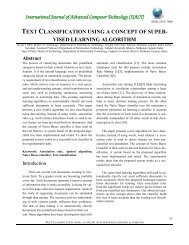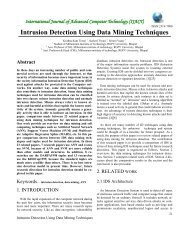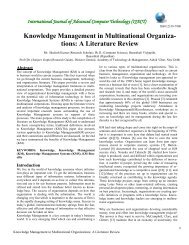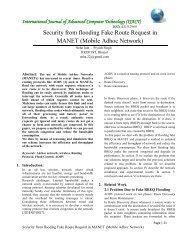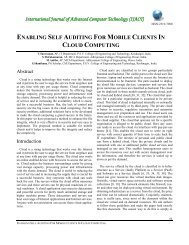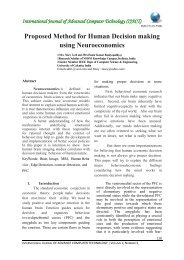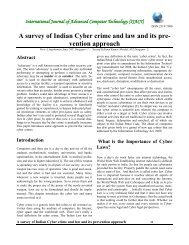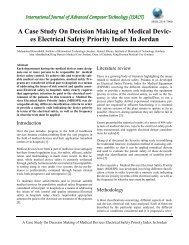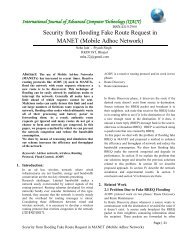Successful Implementation of the Hill and Magic Square Ciphers: A ...
Successful Implementation of the Hill and Magic Square Ciphers: A ...
Successful Implementation of the Hill and Magic Square Ciphers: A ...
Create successful ePaper yourself
Turn your PDF publications into a flip-book with our unique Google optimized e-Paper software.
International Journal <strong>of</strong> Advanced Computer Technology (IJACT)<strong>Successful</strong> <strong>Implementation</strong> <strong>of</strong> <strong>the</strong> <strong>Hill</strong> <strong>and</strong> <strong>Magic</strong><strong>Square</strong> <strong>Ciphers</strong>: A New DirectionISSN:2319-7900Tomba I. : Dept. <strong>of</strong> Ma<strong>the</strong>matics, Manipur University, Imphal, Manipur (INDIA)Shibiraj N, : Research Scholar (Ma<strong>the</strong>matics), CMJ University, Shillong, Meghalaya (INDIA)AbstractIn this paper, <strong>the</strong> applicability <strong>of</strong> a matrix or magicsquares/weak magic squares <strong>of</strong> any order in evaluating numeralsfor encryption <strong>and</strong> decryption is considered. Involvement<strong>of</strong> 2, 13 (factors <strong>of</strong> 26) has been <strong>the</strong> major drawbackfor <strong>the</strong> application <strong>of</strong> <strong>Hill</strong> <strong>and</strong> magic square/ weak magicsquare ciphers in crypto-graphical studies particularly <strong>the</strong>decryption process..The efficiency <strong>of</strong> a cryptographic algorithmis based on <strong>the</strong> time taken for encryption/decryption<strong>and</strong> <strong>the</strong> way it produces different cipher-text from a cleartext.It is observed that weak magic squares (for singly even,n) can produce different ciphertext as far as possible fromplaintext than that <strong>of</strong> <strong>the</strong> actual magic squares. A new approachis developed so as to enable <strong>the</strong> encryption/decryption<strong>of</strong> any matrix or <strong>the</strong> magic squares by introducingdummy letters in addition to <strong>the</strong> existing 26 letters(English).. Introduction <strong>of</strong> selected dummy letters not onlyfacilitate encryption/decryption process but also provideadvantage <strong>of</strong> eliminating duplication <strong>of</strong> letters (vowels) in amessage. The Encryption/decryption process has been madesuitable <strong>and</strong> can provide ano<strong>the</strong>r layer <strong>of</strong> security in anypublic key cryptosystem using magic square or weak magicsquare implementation.1. IntroductionThe efficiency <strong>of</strong> a cryptographic algorithm is based on<strong>the</strong> time taken for encryption, decryption <strong>and</strong> <strong>the</strong> way it producesdifferent cipher-text from a clear-text. Ganapathy <strong>and</strong>Mani (2009) suggested an alternative approach to h<strong>and</strong>lingASCII characters in <strong>the</strong> cryptosystem, a magic square implementation(computer oriented) to enhance <strong>the</strong> efficiencyby providing add-on security to <strong>the</strong> cryptosystem. The encryption/decryptionis based on numerals generated by magicsquare ra<strong>the</strong>r than ASCII values <strong>and</strong> expected to provideano<strong>the</strong>r layer <strong>of</strong> security to any public key algorithms suchas RSA, EL Gamal etc. <strong>Hill</strong> ciphers experienced disadvantagesin decryption because <strong>of</strong> <strong>the</strong> involvement <strong>of</strong> 2 <strong>and</strong> 13(factors <strong>of</strong> 26). Normal magic squares/weak magic squares<strong>of</strong> any order, n (odd, doubly-even <strong>and</strong> singly-even) involvesSUCCESSFUL IMPLEMENTATION OF THE HILL AND MAGIC SQUARE CIPHERS: A NEW DIRECTION2, 13 <strong>and</strong> <strong>the</strong>refore faced difficulties in decryption process asexperienced in <strong>Hill</strong> ciphers.We consider <strong>the</strong> normal magic squares <strong>and</strong> weak magicsquares constructed by expressing in basic Latin square formatfor any n (odd, even). In <strong>the</strong> construction <strong>of</strong> magicsquares for any singly even n, depending upon <strong>the</strong> choice <strong>of</strong><strong>the</strong> central block <strong>and</strong> assignment <strong>of</strong> pair-numbers satisfyingT, different weak magic squares are generated. These weakmagic squares can produce more ciphertext than that <strong>of</strong> <strong>the</strong>actual magic squares.1.1. <strong>Hill</strong> ciphersIn classical cryptography, <strong>the</strong> <strong>Hill</strong> cipher is a polygraphicsubstitution cipher based on linear algebra, developedby Lester S <strong>Hill</strong> in 1929, each letter is assigned a digitin base 26: A= 0, B =1 <strong>and</strong> so on. A block <strong>of</strong> n letters is <strong>the</strong>nconsidered as a vector <strong>of</strong> n dimensions <strong>and</strong> multiplied by an*n matrix, modulo 26. The components <strong>of</strong> <strong>the</strong> matrix are<strong>the</strong> key, <strong>and</strong> should be r<strong>and</strong>om provided that <strong>the</strong> matrix isinvertible to ensure decryption process. If <strong>the</strong> determinant <strong>of</strong><strong>the</strong> matrix is zero or has common factors with <strong>the</strong> modulus(factors <strong>of</strong> 2, 13 in case <strong>of</strong> modulus 26), <strong>the</strong>n <strong>the</strong> matrix cannotbe used in <strong>the</strong> <strong>Hill</strong> cipher.The strength <strong>of</strong> <strong>the</strong> <strong>Hill</strong> cipher is that it completely hidessingle letter frequencies. So it is strong against a ciphertextattack. Security could be greatly enhanced by combiningwith some non-linear step to defeat this attack. A <strong>Hill</strong> cipher<strong>of</strong> dimension 6 was once implemented mechanically, unfortunately<strong>the</strong> gearing arrangements were fixed for any givenmachine, so triple encryption was recommended for security:a secret nonlinear step, followed by <strong>the</strong> wide diffusivestep from <strong>the</strong> machine, followed by a third secret non-linearstep..<strong>Hill</strong> observed that plaintext messages can be encryptedsuccessfully by taking a key matrix <strong>of</strong> size n*n. Again, <strong>the</strong>encrypted ciphertext back into a vector multiplying by <strong>the</strong>inverse <strong>of</strong> <strong>the</strong> matrix. The technique fails to give <strong>the</strong> plaintextproperly due to <strong>the</strong> involvement <strong>of</strong> 2 <strong>and</strong> 13 (factor <strong>of</strong>26) in <strong>the</strong> matrix. An attempt is made in this paper to make<strong>the</strong> <strong>Hill</strong> & weak magic square ciphers work efficiently in83
International Journal <strong>of</strong> Advanced Computer Technology (IJACT)ISSN:2319-7900More discussions on introducing dummy letters(a) There may exists certain languages having 29, 31 <strong>and</strong>37 letters where <strong>the</strong> proposed system can work efficientlybut <strong>the</strong> general question is “what will be its outcomein international scenario”?(b) The system may work but what to be interpreted if <strong>the</strong>(c)decrypted message falls on <strong>the</strong>se dummy variables.The decryption process in <strong>Hill</strong> & weak magic squareciphers generally face difficulties to give <strong>the</strong> plaintextproperly due to <strong>the</strong> involvement <strong>of</strong> 2 <strong>and</strong> 13 (factor <strong>of</strong>26) in <strong>the</strong> matrix.(d) Shifting <strong>the</strong> values (elements) <strong>of</strong> a matrix or weakmagic square beyond 13 (n > 13), to avoid 2 <strong>and</strong> 13 isnot suggested though it gives more reliable results.We may consider a m*m weak magic squares as key <strong>and</strong> amessage with m words (letters/dummy-letters), <strong>the</strong>n <strong>the</strong>message can provide different ciphertext from plaintext asfar as possible depending upon <strong>the</strong> choice <strong>of</strong> <strong>the</strong> centralblock <strong>and</strong> assignment <strong>of</strong> pair-numbers satisfying T in selectivepositions..3. ExamplesConstruction <strong>of</strong> magic squaresExamples for constructing magic squares using basic Latin<strong>Square</strong>s are shown separately for odd order, even order(doubly even <strong>and</strong> singly even cases) magic squares.Case I: For any odd nExample 1: (3 * 3) <strong>Magic</strong> <strong>Square</strong>( nS-1: Write matrix (Fig-1). Here, P = 2 1)2= 5,S-2:S-3:n( n2 1)S =2= 15 for n=3Arranging in basic Latin <strong>Square</strong> format [fig-2] givescolumn totals equalSelecting <strong>the</strong> pivot row, assigning as main diagonalelements <strong>and</strong> rearranging column elements in an orderlymanner gives <strong>the</strong> magic square (fig-3);1 2 34 5 67 8 9Example-2:Fig-1 Fig-2 Fig-3(5 * 5) <strong>Magic</strong> <strong>Square</strong>( nS-1: Write [Fig-1] Here, P = 2 1)2S-2:n( n2 1)1 2 35 6 49 7 88 1 63 5 74 9 2= 13S = = 65 for n = 52Arranging in basic Latin <strong>Square</strong> format gives columnsums equal [fig-2]S-3:Selecting <strong>the</strong> pivot row, assigning as diagonal elements<strong>and</strong> rearranging column elements in an orderlymanner gives (fig-3),1 2 3 4 57 8 9 10 613 14 15 11 1219 20 16 17 1825 21 22 23 24Fig-2Fig-3Example-3: (7*7) <strong>Magic</strong> <strong>Square</strong>A (7 * 7) magic square constructed by applying Latin <strong>Square</strong>principle is given as:30 39 48 1 10 19 2838 47 7 9 18 27 296 6 8 17 26 35 375 14 16 25 34 36 4513 15 24 33 42 44 4Fig-221 23 32 41 43 3 1222 31 40 49 2 11 20Here. P = 25 <strong>and</strong> S = 175Case II: For any doubly-even nExample 4: (4 * 4) <strong>Magic</strong> <strong>Square</strong>S-1: Arranging in basic Latin <strong>Square</strong> format gives with columntotals equaln nHere, S = ( 2 1) 1 2= 34 for n = 4 <strong>and</strong> P lies between8 <strong>and</strong> 9. Find T = 17S-2: Selecting <strong>the</strong> pivot column, assigning as main diagonalelements <strong>and</strong> rearranging gives1 2 3 46 7 8 511 12 9 1016 13 14 15S-3: Making transformations gives ,Extreme corner blocks: 156 15 6 10 31 12 8 134 9 5 1614 7 11 211217 24 1 8 1523 5 7 14 164 6 13 20 2210 12 19 21 311 18 25 2 9,15 11 7 316 12 8 413 9 5 114 10 6 2103 4 9 516 813 147 112 INTERNATIONAL JOURNAL OF ADVANCE COMPUTER TECHNOLOGY | VOLUME 2, NUMBER 3,86
International Journal <strong>of</strong> Advanced Computer Technology (IJACT)S-4: Here, 1 ( n 4) S-5:2= 0 for n = 4 <strong>and</strong> <strong>the</strong>refore nomagic parametric constant is available.No minor adjustment needed <strong>and</strong> <strong>the</strong>refore <strong>the</strong>construction is completed in Step-3.Example 5: (8 * 8) <strong>Magic</strong> <strong>Square</strong>Step-2:Step-3Step-4 & 5Case-III: For any singly-even nExample 6: (6 * 6) magic squareStep-2:61 53 45 37 29 21 13 562 54 46 38 30 22 14 663 55 47 39 31 23 15 764 56 48 40 32 24 16 857 49 41 33 25 17 9 158 50 42 34 26 18 10 259 51 43 35 27 19 11 360 52 44 36 28 20 12 461 12 20 28 36 44 52 53 54 19 27 35 43 14 592 10 47 26 34 23 50 581 9 17 33 25 41 49 578 16 24 40 32 48 56 647 15 42 31 39 18 55 636 51 22 30 38 46 11 6260 13 21 29 37 45 53 461 12 21 28 37 44 52 53 54 22 27 38 43 14 5958 50 47 26 39 23 10 21 9 48 40 32 24 49 5764 56 41 33 25 17 16 87 15 42 31 34 18 55 636 51 19 35 30 46 11 6260 13 20 29 36 45 53 41 2 3 4 5 68 9 10 11 12 7Step-115 16 17 18 13 1422 23 24 19 20 2129 30 25 26 27 2836 31 32 33 34 35Step-3:Step-4Step-5:Step-6:31 12 18 24 30 15 26 17 23 8 354 10 16 15 28 343 9 22 21 27 332 29 14 20 11 3236 7 13 19 25 631 12 13 24 30 15 26 14 23 8 3534 28 16 15 10 43 9 22 21 27 332 29 17 20 11 3236 7 18 19 25 66 12 13 24 30 15 11 14 23 8 3534 28 16 15 10 43 9 22 21 27 332 29 17 20 26 3236 7 18 19 25 31ISSN:2319-79006 32 3 34 35 1 1117 11 27 28 8 30 11119 14 16 15 23 24 11118 20 22 21 17 13 11125 29 10 9 26 12 11136 5 33 4 2 31 111111 111 111 111 111 111 111Note: In <strong>the</strong> construction <strong>of</strong> singly-even magic squares usingbasic Latin squares, selecting a suitable central block, assigning<strong>the</strong> pair-numbers satisfying T in selective positionsis normally complicated. Shifting <strong>the</strong> pair-numbers satisfyingT in positions with 90 0 rotation will provide best results.(i) In many cases, it will generate weak magic squares(ii) Making row <strong>and</strong> column sums equal will affect <strong>the</strong> sum<strong>of</strong> <strong>the</strong> diagonals.(iii) Depending upon <strong>the</strong> choice <strong>of</strong> central block, assignment<strong>of</strong> pair-numbers satisfying T, different forms <strong>of</strong>weak magic squares can be generatedExample 7: For singly-even, n = 6 shown below, pair numberssatisfying T are 18:(i) Corresponding to <strong>the</strong> central block: [16, 21], [17, 20], [1,36], [12, 25], [15, 22], [14, 23], [31, 6] <strong>and</strong> [30, 7] = 8 nos.(ii) Central block: [13, 24] <strong>and</strong> [18, 19] = 2 nos. (iii) Extremecorner blocks: [34, 3], [2, 35], [9, 28], [29, 8], [4, 33],[32, 5], [27, 10], [11, 26] =8 nos.SUCCESSFUL IMPLEMENTATION OF THE HILL AND MAGIC SQUARE CIPHERS: A NEW DIRECTION87
International Journal <strong>of</strong> Advanced Computer Technology (IJACT)ISSN:2319-7900For singly-even, n = 6, pair numbers satisfying T can bedetermined as 2*4 +2+8 = 18 <strong>and</strong> hence for singly-even, n =10, pair numbers satisfying T can be determined as 24WMS-6Different weak magic squares formed assuming centralblock with <strong>the</strong> pair-numbers [13, 24] <strong>and</strong> [18, 19] in differentpositions:WMS-1WMS-2WMS-3WMS-4WMS-534 9 16 21 27 4 1112 29 17 14 11 32 10531 30 24 18 7 1 1116 12 19 13 25 36 1115 26 20 23 8 35 11733 10 15 22 28 3 111111 116 111 111 106 111 11134 9 16 21 27 4 1112 29 23 14 11 32 11131 30 24 18 7 1 1116 12 19 13 25 36 1115 26 20 17 8 35 10533 10 15 22 28 3 111111 116 117 105 106 111 11134 9 22 15 27 4 1112 29 17 14 11 32 10536 25 13 19 12 6 1111 7 18 24 30 31 1115 26 20 23 8 35 11733 10 21 16 28 3 111111 106 111 111 116 111 11134 9 22 15 27 4 1112 29 23 14 11 32 11136 25 13 19 12 6 1111 7 18 24 30 31 1115 26 20 17 8 35 11133 10 21 16 28 3 111111 106 117 105 116 111 11134 9 16 21 27 4 1112 29 17 20 11 32 11131 30 18 13 12 1 1056 7 24 19 25 36 1175 26 14 23 8 35 11133 10 22 15 28 3 111111 111 111 111 111 111 11134 9 16 21 27 4 1112 29 17 20 11 32 111The above illustrations shows that different forms <strong>of</strong>weak magic squares can be generated, depending upon <strong>the</strong>choice <strong>of</strong> central block <strong>and</strong> assignment <strong>of</strong> pair-numbers satisfyingT in different positions.4. IllustrationsIllustration 1: Using 5 selected dummy letters, <strong>the</strong> messageSEA SE a corresponds to plaintext <strong>of</strong> [ 18 27]37 Let <strong>the</strong> matrix A= A = 1 ≠ 0 <strong>and</strong> A -1 exists512 Encryption: 3 7 * 18 243mod31 512 mod31 2741426 represents <strong>the</strong> ciphertext, [A o L]11Decryption A -1 =12 7 5 3Now, A -1 C =12 726* mod 31235 mod 315 311 97 18 giving <strong>the</strong> original plaintext <strong>of</strong> SEa or SEA 27Illustration 2: Consider <strong>the</strong> message HOUR representedas HO u R corresponds to <strong>the</strong> plaintext <strong>of</strong> [7 30 17]Let <strong>the</strong> matrix A= 1 2 3 2 5 7 2 4 5 1 2 3 7 118 Encryption: *2 5 7 mod 31 mod 31 30283 2 4 517 219 25 represents <strong>the</strong> ciphertext,: [Z E O o ] 429Decryption: A = 1 <strong>and</strong> A -1 =Now, A -1 C = 3 4231 30 18 13 12 7 111INTERNATIONAL 6 JOURNAL 1 OF 24 ADVANCE 19 25 COMPUTER 36 111 TECHNOLOGY | VOLUME 2, NUMBER 3,5 26 14 23 8 35 11133 10 22 15 28 3 111 210 3 2 4 12 01* 1 41 29111 25 mod 3188
International Journal <strong>of</strong> Advanced Computer Technology (IJACT)ISSN:2319-790038 7 2 corresponds to <strong>the</strong> original plaintext <strong>of</strong> COE mod31125 301479 174It corresponds to <strong>the</strong> original plaintext: HO u R or HOUR The involvement <strong>of</strong> <strong>the</strong> factors <strong>of</strong> 2 or 13 in any matrix isnot affecting <strong>the</strong> encryption <strong>and</strong> decryption process if <strong>the</strong>Illustration 3: Let <strong>the</strong> message be HOUR HO u R matrix or magic square is non singular.<strong>the</strong> plaintext: [7 30 17]Let A be a (3x3) magic square A= 81 6Illustration 5: Suppose <strong>the</strong> message is to be encrypted be 3 5 7FLOWER (6 letters)4 9 2Taking A= 0, B =1, C = 2 ...Z=25, A u =26, E a =27, E e =28,81 6Encryption: * 7188mod3 5 7 31 mod 31 O o =29, O u =30, <strong>the</strong> message FLOWER gives <strong>the</strong> plaintext 30290[05 11 14 22 04 17]4 9 217332We may consider two weak magic squares (singly-even) as:2 represents <strong>the</strong> ciphertext: [C L W] 1134 9 22 15 27 4 34 9 16 21 27 4222 29 23 14 11 32Decryption: A = 1 <strong>and</strong> A -1 = 2425 112 29 17 14 11 32 7 20 236 25 13 19 12 6 31 30 24 18 7 129 15 16Now,A -1 2425 112 565 1 7 18 24 30 316 12 19 13 25 36C = *7 20 2 mod 31 11 mod31 278 5 26 WMS-Fig-A 20 17 8 35 5 26WMS-Fig-B20 23 8 3529 15 162257533 10 21 16 28 3733 10 15 22 28 3 corresponds to <strong>the</strong> plaintext HO30u R or HOUR17WMS-Fig-AWMS-Fig-BIllustration 4: Consider <strong>the</strong> message COE that corresponds Encryption Process:to <strong>the</strong> plaintext: [2 14 4]Let <strong>the</strong> matrix A= 0 13 14For encryption, a block <strong>of</strong> 6 (six) letters is considered as a 19 6 4vector <strong>of</strong> 6 dimensions <strong>and</strong> multiplied by a 6*6 weak magic12 1 25square modulo 31. Since <strong>the</strong> matrix is invertible A 0 ,Encryption: 0 13 14* 2 238mod 31 19 6 4 mod 31 decryption is ensured. Now, ciphertext = [{(6*6) weak magicsquare}* plaintext] mod 31. 14 13812 1 254 148Let CT be <strong>the</strong> encrypted ciphertext <strong>of</strong> <strong>the</strong> message by21using 6*6 weak magic squares shown above. 14 represents <strong>the</strong> ciphertext [V O Y]CT (1) = [WMS-Fig-A] * [05 11 14 22 04 17] mod 31 [15 06 22 0 19 16] corresponds to <strong>the</strong>24ciphertext PGWATQDecryption: A = 6453 <strong>and</strong> A -1 146311 32 CT (2) = [WMS-Fig-B] * [05 11 14 22 04 17] mod 31= 1 407 238 2666453 [29 28 27 21 11 30] corresponds to83 221 247 <strong>the</strong> ciphertext O O E E E A V L O UUsing <strong>the</strong> multiplicative inverse <strong>of</strong> 6453 mod 31 5 modDecryption Process:31 as 25 mod 31, it gives:Decryption is done by calculatingA -1 8 25 25= M (1) = (WMS-Fig-A) -1 * CT (1) mod 317 29 15M (2) = (WMS-Fig-B) -1 * CT (2) mod 3129 24 6 Here,A -1 8 25 2521C = *7 29 15 mod 311118 14 mod 31 WMS, Fig A = 230892091329 24 6 24 1089SUCCESSFUL IMPLEMENTATION OF THE HILL AND MAGIC SQUARE CIPHERS: A NEW DIRECTION89
International Journal <strong>of</strong> Advanced Computer Technology (IJACT)ISSN:2319-79001227647247301 128412 214524 52749 1042243A -1 29730 198850 11280 89400 91210 59250= 1 993870 431450 275280 364080 64370 715590 2308920 577230 1924100 0 192410 577230 548790 530 22440 104160 90790 539190 919393 190059 1357081347961211 806597Using <strong>the</strong> multiplicative inverse <strong>of</strong> 2308920 mod 31 9mod 31 as 7 mod 31, it gives:Now, {Inverse <strong>of</strong> WMS-Fig-A} mod 31195 23 3 29= 24 19 28 28 62325 0 19 52318 0 0 132110 3 0 12717 8 6 17Here,WMS, Fig B = 66600251 mod 31268 186 70179 16537 14208 9768 27115A -1 38322 18646 11544 7104 25450= 1 152154 46622 36408 27528 7445066600 185454 57722 36408 27528 85550 111582 38626 24864 20424 58750 113025 29635 131579400 17760 45958Using <strong>the</strong> multiplicative inverse <strong>of</strong> 66600 mod 31 12 mod 31 as 13 mod 31: it gives{Inverse <strong>of</strong> WMS-Fig-B} mod 312827 6 816 9 1 3= 1526 4 0300 4 0140 26 281818 2 23613302528982977 49566188862 222162 1361461360356 86 mod3122162M (1) = (WMS-Fig-A) -1 *CT (1) mod 31 [05 11 14 22 04 17] Original plaintext <strong>of</strong> <strong>the</strong> message, FLOWERM (2) = (WMS-Fig-B) -1 *CT (2) mod 31 [05 11 14 22 04 17] original plaintext <strong>of</strong> <strong>the</strong> message FLOWERWith <strong>the</strong> application <strong>of</strong> two different weak magic squares,encryption <strong>and</strong> decryption can be taken up without any difficulty<strong>and</strong> <strong>the</strong> original plaintext <strong>of</strong> <strong>the</strong> message, FLOWERcan be achieved on decryption.Illustration 6: Add-on security in <strong>the</strong> cryptosystem usingweak magic square implementationTo show <strong>the</strong> relevance <strong>of</strong> this work to <strong>the</strong> security <strong>of</strong>public-key encryption schemes, a public-key cryptosystemRSA is taken. For convenience, let us consider a RSA cryptosystem,Let p = 11, q = 17 <strong>and</strong> e = 7, <strong>the</strong>n n = 11(17) = 187, (p-1)(q-1) = 10(16) = 160. Now d = 23. To encrypt, C = M 7 mod 187<strong>and</strong> to decrypt, M = C 23 mod 187.Encryption Process:First <strong>the</strong> message is encrypted using two different weakmagic squares : WMS-Fig-A <strong>and</strong> WMS-Fig-B.The plaintext represents [05 11 14 22 04 17] <strong>of</strong> <strong>the</strong> messageFLOWERThe encrypted ciphertext using WMS-Fig-A <strong>and</strong> WMS-Fig-B, as shown earlier represent;CT (1) = [15 06 22 0 19 16]CT (2) = [29 28 27 21 11 30]The encrypted ciphertext CT (1) <strong>and</strong> CT (2) are again encryptedusing C = M 7 mod 187, denoted by C (1) <strong>and</strong> C (2) ;C (1) = {CT (1) } 7 mod 187 [93 184 44 0 145 135]C (2) = {CT (2) } 7 mod 187 [ 160 173 124 98 88 123]Decryption Process:Decryption is done by calculating M = C 23 mod 187 for <strong>the</strong>two Ciphertext C (1) <strong>and</strong> C (2) . It gives <strong>the</strong> decrypted ciphertextCT (1) <strong>and</strong> CT (2)CT (1) = [C (1) ] 23 mod 187 [15 06 22 0 19 16]CT (2) = [C (2) ] 23 mod 187 [29 28 27 21 11 30]These decrypted ciphertext in two forms are again decryptedto get <strong>the</strong> original message.(WMS-Fig-A) -1 * CT (1) mod 31 [05 11 14 22 04 17] Corresponds to <strong>the</strong> original plaintext <strong>of</strong> FLOWER(WMS-Fig-B) -1 * CT (2) mod 31 [05 11 14 22 04 17] Corresponds to <strong>the</strong> original plaintext <strong>of</strong> FLOWERIt indicates that any non singular matrix or magic squareor weak magic squares can be comfortably used as add-ondevice to a cryptosystem. The technique will provide ano<strong>the</strong>rlayer <strong>of</strong> security to <strong>the</strong> cryptosystem as observed by Ganapathy<strong>and</strong> Mani (2009). This work can be regarded as <strong>the</strong>oreticaldevelopment because <strong>the</strong> time taken for encryption <strong>and</strong>decryption has not been calculated that needs practical experimentsusing computers.5. Discussions on Practical ApplicationThe proposed dummy letters are <strong>the</strong> <strong>the</strong>oretical developmentsfocusing on its merit <strong>and</strong> advantages in using magicsquares or any type <strong>of</strong> matrices in encryption <strong>and</strong> decryptionprocesses. In facts, <strong>the</strong> introduction <strong>of</strong> 5 dummy letters willaffect <strong>the</strong> ASCII characteristics <strong>the</strong>reby inviting troubles ino<strong>the</strong>r uses.However, spaces for introducing such dummy letterscan be made available if <strong>the</strong> proposal is acceptable for implementationthroughout <strong>the</strong> world. If implemented, it willINTERNATIONAL JOURNAL OF ADVANCE COMPUTER TECHNOLOGY | VOLUME 2, NUMBER 3,90
International Journal <strong>of</strong> Advanced Computer Technology (IJACT)ISSN:2319-7900give a new direction to <strong>the</strong> Computer operators <strong>and</strong> specificallya new direction to <strong>the</strong> crypt analyzers.6. ConclusionsThe technique developed by Tomba (2012) can be usedfor finding magic squares using basic Latin <strong>Square</strong>s <strong>of</strong> anyorder (n ≥ 1). However, for singly-even n, <strong>the</strong> technique cangenerate different weak magic squares depending upon <strong>the</strong>choice <strong>of</strong> <strong>the</strong> central block <strong>and</strong> assignment <strong>of</strong> pair-numberssatisfying T in different positions. Weak magic squares ormatrices <strong>of</strong> any order (non-singular) can also be used as addondevice to any cryptosystem. The instruction <strong>of</strong> dummyletters is to reduce <strong>the</strong> repetitions <strong>of</strong> vowel letters <strong>and</strong> tomake <strong>the</strong> total number <strong>of</strong> letters as 31 (prime number)against <strong>the</strong> existing 26 letters. The process will affect ASCIIcharacteristics. If considered for implementation <strong>of</strong> a similarprocess, a new direction for encryption <strong>and</strong> decryption willbe provided making <strong>the</strong> decryption more complicated givingdifficulties particularly to <strong>the</strong> crypt analyzers.AcknowledgmentsThe authors are thankful to IJACT Journal for <strong>the</strong> support todevelop this document.References[1]. Abe, G.: Unsolved Problems on <strong>Magic</strong> <strong>Square</strong>s; Disc.Math. 127, 3-13, 1994[2] Barnard, F. A. P: Theory <strong>of</strong> <strong>Magic</strong> <strong>Square</strong>s <strong>and</strong>Cubes; Memoirs Natl. Acad. Sci. 4, 209-270, 1888.[3] Carl, B Boyer (Revised by Uta, C. Merzbach): A History<strong>of</strong> Ma<strong>the</strong>matics, Revised Edition, 1998[4] Gardner, M: <strong>Magic</strong> <strong>Square</strong>s <strong>and</strong> Cubes; Ch. 17 inTime Travel <strong>and</strong> O<strong>the</strong>r Ma<strong>the</strong>matical Bewilderments.New York: W. H. Freeman, pp 213-225, 1988[5] Flannery, S. <strong>and</strong> Flannery, D.: In code: A Ma<strong>the</strong>maticalJourney, London’s Pr<strong>of</strong>ile Books, p16-24, 2000[6] Heinz, H <strong>and</strong> Hendricks J. R.: <strong>Magic</strong> <strong>Square</strong>s Lexicor,Illustrated Self Published, 2001[7] Hirayama, A. <strong>and</strong> Abe, G: Researches in <strong>Magic</strong><strong>Square</strong>s; Osaka, Japan: Osaka Kyoikutosho, 1983.[8]. McCranie, Judson: <strong>Magic</strong> <strong>Square</strong>s <strong>of</strong> All Orders,Ma<strong>the</strong>matics Teacher, 674-678, 1988[9] Pickover, C. A.: The Zen <strong>of</strong> <strong>Magic</strong> <strong>Square</strong>, Circles<strong>and</strong> Stars: An Exhibition <strong>of</strong> Surprising StructuresAcross Dimensions, NJ: Princeton University Press,2002[10] Tomba I. A Technique for constructing Odd-order<strong>Magic</strong> <strong>Square</strong>s using Basic Latin <strong>Square</strong>s, InternationalJournal <strong>of</strong> Scientific <strong>and</strong> Research Publications,Vol-2, Issue-5, May 2012, pp 550-554SUCCESSFUL IMPLEMENTATION OF THE HILL AND MAGIC SQUARE CIPHERS: A NEW DIRECTION[11] Tomba I. A Technique for constructing Even-order<strong>Magic</strong> <strong>Square</strong>s using Basic Latin <strong>Square</strong>s, InternationalJournal <strong>of</strong> Scientific <strong>and</strong> Research Publications,Volume-2, Issue-7, July 2012.[12] Tomba I. On <strong>the</strong> Techniques for constructing Evenorder<strong>Magic</strong> <strong>Square</strong>s using Basic Latin <strong>Square</strong>s, InternationalJournal <strong>of</strong> Scientific <strong>and</strong> Research PublicationsVol-2, Issue-9, Sept 2012.[13] Tomba I. <strong>and</strong> Shibiraj N.: Improved Techniques forconstructing Even-order <strong>Magic</strong> <strong>Square</strong>s using BasicLatin <strong>Square</strong>s, International Journal <strong>of</strong> Scientific <strong>and</strong>Research Publications Vol-3, Issue-6, June 2013BiographiesTomba received <strong>the</strong> degrees <strong>of</strong> B.Sc.Hon’s (Statistics)from <strong>the</strong> University <strong>of</strong> Gauhati, Guwahati, in 1974, M.Sc(Statistics) from <strong>the</strong> Banaras Hindu University, Varanasi in1976 <strong>and</strong> <strong>the</strong> Ph.D.(Ma<strong>the</strong>matics) from <strong>the</strong> Manipur University,Imphal 1992, respectively. Currently, he is working asAssociate Pr<strong>of</strong>essor in <strong>the</strong> Department <strong>of</strong> Ma<strong>the</strong>matics, ManipurUniversity. His research interest includes ma<strong>the</strong>maticalmodeling, operations research, probability <strong>the</strong>ory, populationstudies <strong>and</strong> cryptography.Shibiraj received <strong>the</strong> degrees <strong>of</strong> M.Sc..(Ma<strong>the</strong>matics)from <strong>the</strong> University <strong>of</strong> Banglore, Banglore in 2007 <strong>and</strong> currentlya research scholar in Ma<strong>the</strong>matics in CMJ university,Meghalaya..91



